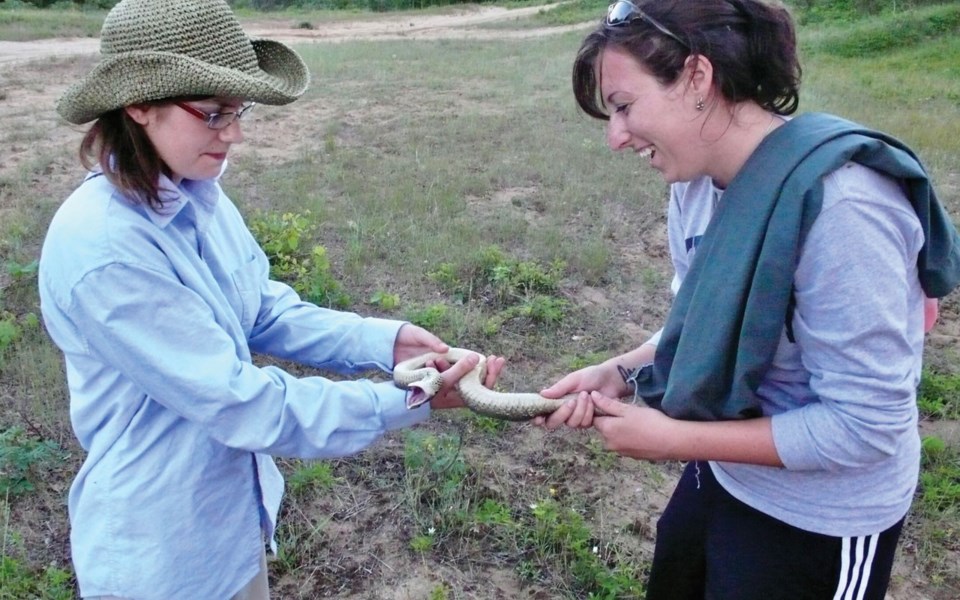As a nature-addled kid, I spent most of my time combing the gardens and ravines of our neighbourhood, and my earliest memories are of watching ants build nests, spiders eating the ants, and birds hoovering the spiders. The web of life was my TV.
Early on, I became interested in reptiles and amphibians, conveniently lumped under the same zoological rubric of herpetology. I obsessed to the point of wrestling four or five books on the subject home from the library every month. In high school, that focus waned when I discovered canoeing, girls, partying, and skiing (pretty much in that order). It wasn't until I enrolled in a biology program at the University of Waterloo that I really dug back in, lapping up courses in invertebrate and vertebrate zoology, de facto extensions of the sandbox occupations of youth.
Nevertheless, the only career aspiration I held was that whatever I did, the outdoors had to be involved. Maybe I'd find my way there through biology, maybe not. Who knew? But then, as for many during similar drift, an unexpected event set my course. After my sophomore year, I landed a summer job conducting biological inventories in an Environmentally Sensitive Area of southwestern Ontario.
Though this first opportunity to be paid for my biological knowledge made the wages at a car wash seem attractive, in every other way it was a dream job. There were four of us on the crew: three birder/botanists from the university's Environmental Studies program, and myself, a bona fide zoologist responsible for fish, amphibians, reptiles, mammals and invertebrates. Our daily routine involved driving an hour to one of the green blots on our mud-stained topographic map, then debarking in the middle of nowhere as a rolling visage of The Far Side, swathed in rubber boots, nets, backpacks, binoculars, notebooks and insect repellant. We'd split up, pick a meeting time back at the cars, and tramp off. I then spent an entire morning doing what I'd self-trained much of my life for: laying careful, respectful siege to nature. I turned rocks and logs, peered into ponds and marshes, sloshed through flooded forests; I identified frogs by their calls, egg masses, and the way they leapt into water; I ogled distant turtles through binoculars, identifying species by the shape of their shells; I chased all manner of snake through high grass and rock piles.
Wandering, wading, and wallowing, my nostrils flared with the pungent miasma of what 19th-century writers termed the "Chthonic Domain." Aristotle had ascribed worms, salamanders and snakes to this earthy, subterranean realm with its spirits and gods of the terra firma. It was where I belonged—a farmer working his fetid fields, reconnected and rekindled.
Sightings of rare birds and plants accumulated rapidly from the others, but my work turned largely on confirming harder-to-find critters. One that presented as a gift significantly ratcheted up the area's biodiversity quotient. Returning to the cars one day, we found the twisted, upturned body of a stout, arm-length snake lying between them. It lay in a cream-coloured 'S,' mouth agape, tongue lolling comically. "That's pretty big," said a nervous botanist. "Did we run it over?" wondered another. "It's not dead," I smiled. "Watch."
Leaning down, I slipped a hand under the moribund snake and gently flipped it, revealing the brown-and-gray-banded dorsum and upturned nose of an Eastern Hognose Snake. The animal rolled right back over and resumed its possum pose. I flipped it again. It rolled over again. All you could do was laugh. It was like a Monty Python skit. Me: "You're not dead." Snake: "Yes I am" Me: "No you're not." Snake: "I bloody well am!"
Diurnal toad-hunters that prefer sandy areas where they can turn out prey with their shovel-like snouts, Hognose snakes are also nature's best attempt at a solo Shakespearean drama. When threatened, the curtain rises on a loudly hissing snake spreading its foreparts like a cobra. Unlike the real thing, however, this snake isn't venomous—reason for the rest of the show. If the threat doesn't back off, Act II involves a savage display of striking with its mouth comically closed. The finale, of course, is feigning death. This often-misinterpreted behavioural revue makes the Hognose one of Canada's most persecuted—and rarest—snakes.
That summer's fieldwork also involved plenty of forensics. Long before CSI made it popular, I learned to confirm the presence of animals by their tracks, shed skins, bones, or scat. A flipside was that I personally served as a forensic lab for the rest of the crew, who determined the presence of poison ivy, poison oak, stinging nettle and numerous insects by examining the welts, cuts, bites and stings blooming across my legs and arms.
Regardless, I fell in love with fieldwork, a major reason why I went on to a Doctorate in zoology, stretching out the degree so I could bag extra field seasons. When I eventually switched to writing full time, it was the fieldwork aspect of my previous vocation that resonated most clearly in my work—crazy tales of woe, misery and mirth in the wild became staples of my books and magazine assignments. And now, whenever I'm out in the field, one thing is clear to me: that summer job turned a nature-addled kid into a nature-addled adult.
Leslie Anthony is a biologist, writer and author of several popular books on environmental science.




